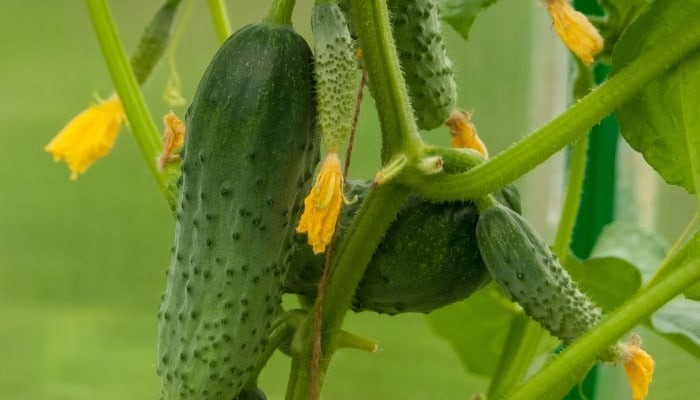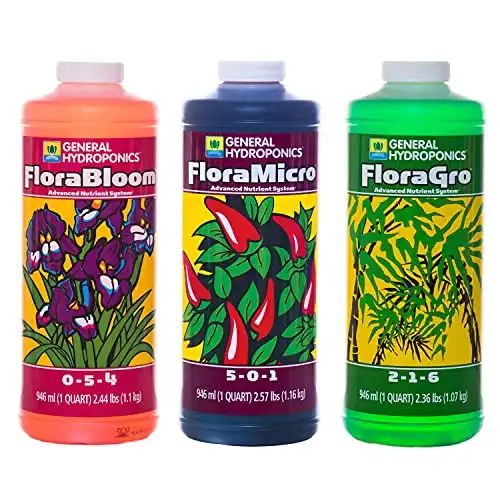Growing cucumbers in soil can be a challenging task. The multitude of problems that can arise may dissuade some gardeners from attempting it.
Luckily you can grow hydroponic cucumbers and enjoy a high yield without the usual hassles cucumber plants are famous for.
Can cucumbers be grown hydroponically? Since cucumbers have a fast growth rate and relish moisture and warmth, a hydroponic system provides the ideal conditions for them to thrive. Choose varieties such as Beit Alpha, Bush Champion, or Spacemaster since they’re ideal for hydroponics and tend to have high yields.
As you can imagine, there’s more to growing cucumbers hydroponically than selecting a good system and picking the right variety.
This guide covers everything you need to know about hydroponic cucumbers from starting the seeds all the way to harvest time.
Best Hydroponic System for Cucumbers
Hydroponic systems come in many shapes, sizes, and varieties. Each has its own advantages and works for certain plants.
When it comes to cucumbers, the best hydroponic systems are the drip system, the ebb-and-flow system, and the Dutch bucket system.
Here’s the lowdown of each one and when to choose it over the others.
Drip System
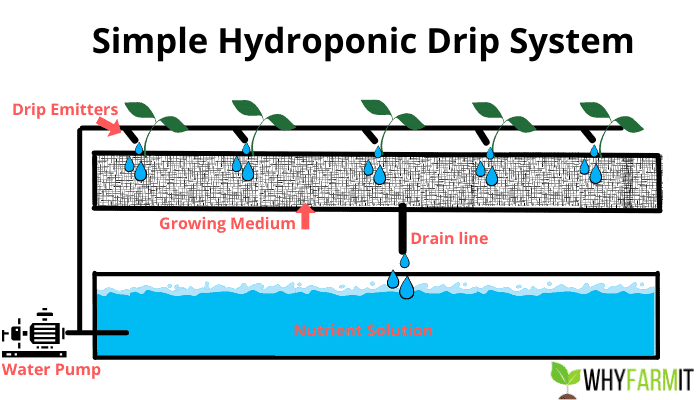
The drip system often requires more space, making it more suitable for commercial use rather than for residential dwellings.
Each cucumber plant will be suspended with its roots firmly in a net pot submerged in shallow water.
The pots are connected with channels where water is in continuous movement and pumped with oxygen and nutrients.
At the end of the channel, the water dumps into the reservoir to be reused.
Ebb and Flow
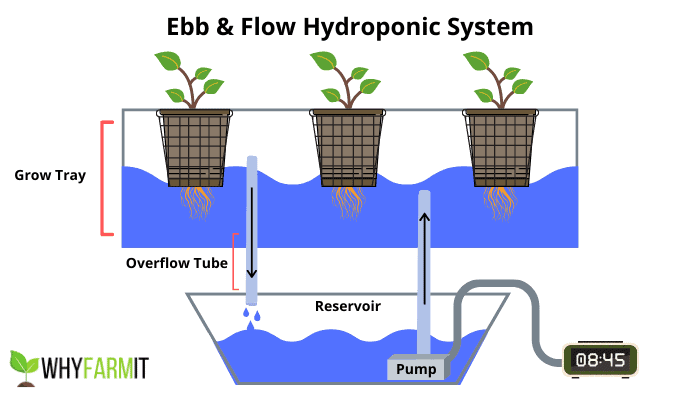
The ebb-and-flow system involved flooding the cucumber plant with nutrients from time to time based on a preset schedule.
It’s different from the drip system since it doesn’t keep the nutrients in the water regularly.
When you pump the nutrients in the tray, gravity will take care of draining them where they fall into the reservoir.
It’s a simpler system to set up and only requires a timed pump for handling the feeding part.
Dutch Bucket System
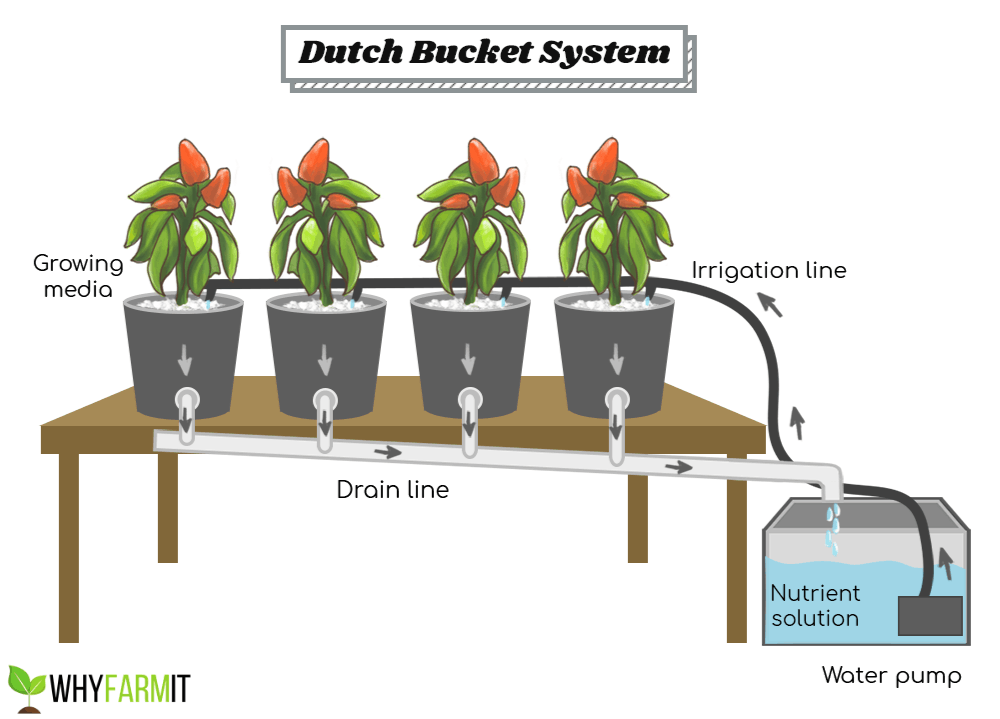
The Dutch bucket is an efficient system that works in small spaces and is quite conservative with its water usage.
It involves growing the cucumber plants in buckets full of perlite, coco coir, or vermiculite.
This improves the aeration, which in turn gives high yields. You can line the buckets in any arrangements you prefer to take advantage of the available space.
Best Cucumber Varieties for Growing Hydroponically
Naturally, not all cucumber varieties are suitable for hydroponic growing. Most natural cucumber species tend to turn bitter if you leave them on the vine for too long.
Bush cucumber varieties, on the other hand, are best suited to grow hydroponically. To get a good harvest with your hydroponic cucumbers, you should choose one or more of the following varieties:
Spacemaster
The Spacemaster is compact and smallish bush with excellent yield and high tolerance to warm temperatures and high humidity levels.
The fruits have a uniform shape and grow to about 7 to 9 inches long. The compact bushes make them ideal for small spaces.
Bush Champion
This is another compact variety that produces large fruits. The fruit averages about 11 inches long and is easy to slice and has a pleasant taste and flavor.
The bush averages 10 inches long, making it easy to spot the fruits and monitor their development until harvest time.
Beit Alpha
The fruits of this variety are very sweet with thin skin. The Beit Alpha is an open pollinator and won’t require other pollinators, making it ideal for growing indoors or in greenhouses.
Lemon Cucumber
A novelty heirloom variety with round fruits the size of a tennis ball. The ripe fruit is usually yellow with thick skin and plenty of seeds in the core.
You can grow this variety using the Dutch bucket system to get a high yield.
How Do You Start Hydroponic Cucumber Seeds?
To start the seeds of the cucumber in a hydroponic system, it’s not recommended to leave them in water until they germinate.
A more suitable medium such as coco coir or mineral wool should be provided. The seeds themselves have a high rate of germination and take between 3 to 10 days to sprout.
Place the seeds in 4 inches of the medium and keep the temperature between 75 and 85℉.
How To Grow Hydroponic Cucumbers
For seeded cucumber varieties, it’s best to start the plants from seeds as we explained above. The plants have a fast growth rate and mature quickly.
As for the seedless varieties, you can clone them using hydroponics. It’s a time-intensive process, but you always end up with a plant similar to the old one.
If neither of those methods works for you, you can transplant a seedling from the soil to the hydroponic system.
What Is the Best Way To Support Hydroponic Cucumber Plants?
If you’re growing bush cucumber varieties, you won’t need to support them, but other varieties would need a trellis near each hydroponic system.
Train the stem of the plant along the wires of the trellis, and then wait for it to latch on before pinching off the tip.
This triggers two stems to grow out of it, which will keep climbing the trellis. Repeat with other stems as necessary.
How Long Do Cucumbers Take To Grow Hydroponically?
On average, your hydroponic cucumber won’t need more than 70 days to mature and be ready to harvest.
Some varieties will have ripe fruits in no more than 50 days from the day you plant the seeds. Cucumber cultivars generally mature faster than natural species.
The ideal conditions of the hydroponic systems with their abundant nutrients speed up the maturity of the cucumbers.
How Many Cucumber Plants Can I Grow in a 5-Gallon Bucket?
If you choose the Dutch bucket hydroponic system, then you can grow two or three bush cucumber plants in each bucket.
If you’re planting climber cucumber vines, then stick to two plants per bucket, and provide one wide trellis for both plants.
Hydroponic Cucumber Yield Per Plant
The yield of the hydroponic cucumber plant varies depending on the cucumber variety you’re growing. Some fruits are larger and heavier than others as well.
On average, you can expect anything from one and a half to three pounds of cucumbers every week during the harvest season.
By the end of the year, each plant could produce anything from 20 to 25 fruits.
Hydroponic Cucumber Pollination
Not all cucumber plants growing hydroponically require pollination, but if your cucumber variety needs to be pollinated, you can do that yourself.
Use a small paintbrush or a cotton swab to collect the pollen off the male flower by rubbing it gently.
Then dip it inside the swollen part of the female flower, and rub it gently against the inside wall of the flower.
The female flower will wilt and fade after that, and the fruit will develop inside the swollen part.
Hydroponic Cucumber Nutrients
Once the seedling starts growing, you can add a hydroponic nutrient solution with high nitrogen content.
Before flowering time, switch to a hydroponic nutrient solution with more phosphorus and potassium concentrations to increase the number of flowers on each plant.
General Hydroponics makes a 3-pack bundle of nutrients for every growth stage – it’s an ideal solution and makes providing the right balance of nutrients easy!
Hydroponic Cucumber Fertilizer Formula
Like most other veggies, hydroponic cucumber needs three basic nutrients to grow successfully and produce a high yield. These are nitrogen, phosphorus, and potassium.
You can make your own hydroponic cucumber fertilizer at home by adding 3 ounces of an 8-16-36 hydroponic fertilizer, 3 ounces of soluble calcium nitrate, and 2 ounces of magnesium sulfate.
Mix well, and apply to the hydroponic system as needed.
Hydroponic Cucumber Nutrient Deficiencies – Signs
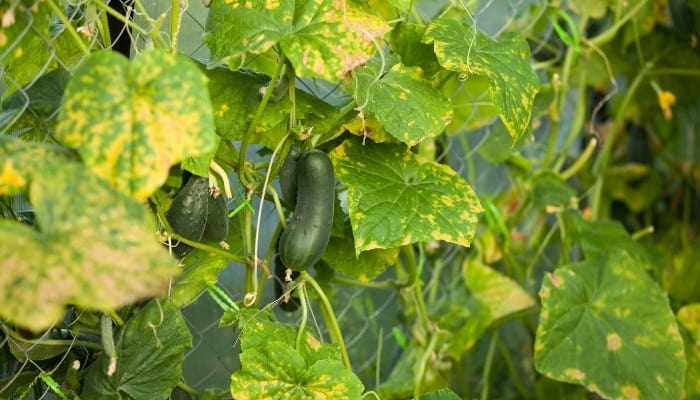
Each one of the nutrients we listed above contributes to the overall health and growth of the hydroponic cucumber plant.
When one or more of those nutrients is missing, the plant can suffer and show signs and symptoms that correspond with that particular nutrient deficiency.
Here’s a list of the common nutrient deficiencies and their symptoms.
- Potassium Deficiency: The edges of the leaves turn yellow and show signs of scorching between the veins.
- Magnesium Deficiency: Yellowing between the veins that quickly turns into a tan color.
- Nitrogen Deficiency: Stunted growth and leaves turning pale green.
- Phosphorus Deficiency: Poor plant growth and dull green foliage.
Hydroponic Cucumber pH
Since the roots of the hydroponic cucumber plants will be submerged in water, you need to monitor the pH of the water and the medium the roots are growing in regularly.
Make sure the pH is between 5.5 to 6.0 at all times. This easy-to-read monitor is accurate and provides readings instantly. It also measures the water temperature, which is important for success.
EC for Hydroponic Cucumbers
Electrical conductivity (EC) is important for the growth of hydroponic cucumbers. You should use EC between 2.0 and 3.0 mS/cm.
Can You Grow Hydroponic Cucumbers Indoors?
You can easily grow hydroponic cucumbers indoors as long as you provide adequate light, maintain temperatures between 70 to 85℉, and keep the humidity levels high.
If the plants need to be pollinated, you’ll have to do it manually during the small window when both the male and female flowers are fertile.
Improve air circulation around the plants to prevent infections and pest infestations.
Do Hydroponic Cucumbers Have Seeds?
Hydroponic cucumbers are not much different from regular cucumbers in terms of the size of the plant or the fruits produced.
If you plant a seed of a cucumber variety hydroponically, the fruits that you harvest 7 weeks later will also have seeds.
So whether the fruits will have seeds or not depends on the variety of the cucumber – not how it’s grown.
Common Hydroponic Cucumber Problems
Unlike their garden counterparts, hydroponic cucumbers enjoy higher levels of humidity and heat throughout the life of the plant.
This is often fertile grounds for many diseases and pest infestations.
For diseases, you need to keep an eye out for gummy stem blight and powdery mildew. Both of these are fungal infections that spread in areas with poor circulation.
Remove the infected leaves or whole plants with severe infection, and place a fan near the plants to improve airflow.
Pests such as broad mites and two-spot spiders also find refuge among the foliage of the hydroponic cucumber plants where they lay their eggs on the underside of the leaves. They often feed on the foliage.
Treat them with neem oil spray, or rub the leaves with a swap soaked in rubbing alcohol.
Wrapping It Up
Hydroponic cucumbers have a higher yield than those growing in the soil.
You can use a suitable hydroponic system, such as the drip system or the ebb-and-flow system, and select a compact bush cucumber variety for the best results.

